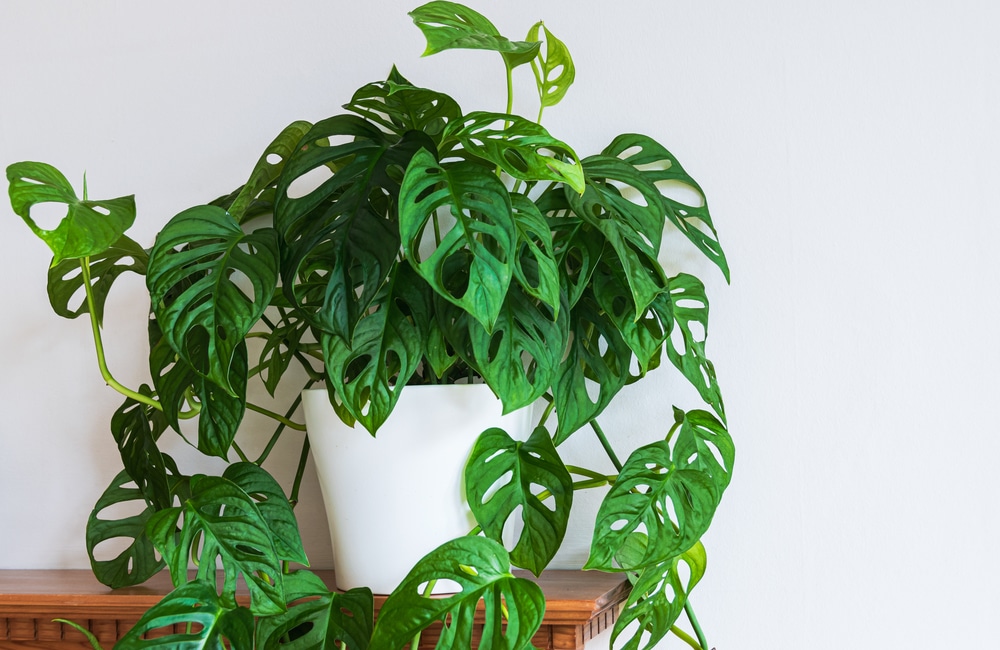The Philodendron monstera is a common tropical plant that’s grown in homes, offices, and waiting rooms around the world. This plant has large distinctive leaves with holes in them and is commonly called a Swiss-cheese plant. These attractive plants can grow very large in their native environment, but their growth will be stunted when grown indoors.
In the wild, they grow beautiful white flowers that look similar to the flowers of a peace lily. During the summer months, edible fruit will develop. Unfortunately, most Swiss cheese plants that are kept as house plants will never flower. Let’s look at how to grow and care for a Philodendron Monstera.
What is a Philodendron Monstera?
The Philodendron Monstera is often referred to as a Swiss cheese plant or a window leaf plant due to the holes in its foliage. These plants aren’t actually Philodendrons; they are botanically classified as Monstera deliciosa. Plants with the name deliciosa are tropical fruiting plants, and the name refers to the tasty fruit the plant produces. These unusual tropical fruits taste like a combination of banana, pineapple, and mango.
Monstera refers to the size of the species as these plants can reach a height of 20 feet in their native environment. When kept as a houseplant, growth is stunted, and your plant is unlikely to get larger than nine feet tall. The Philodendron Monstera is a climbing plant that produces long, woody vines. Most people find that their plants require support as they get larger.
Philodendron Monstera Care
Philodendron Monstera plants are relatively easy to care for and are fast-growing if conditions are right. It’s a good idea to spend time getting the basics of sunlight, water, soil, and humidity right when you first get your plant. Here are some tips to help you grow a thriving Philodendron Monstera plant:
Sunlight
Much like the Monstera Standleyana, Philodendron Monstera requires enough light to keep their leaves healthy. Incorrect light can affect the plant’s fenestration. It’s best to place your plant in bright indirect sunlight throughout the growing season. In winter, your plant can be placed in direct sunlight. Be careful not to leave a Philodendron Monstera in the scorching sun during the summer, or its leaves may get burned.
If your home doesn’t get enough natural light from the windows, you may like to invest in a grow light to help your plant get the light it needs to thrive. If your plant’s foliage is growing without perforations, this is a sure sign it needs more light.
Watering Requirements
Philodendron Monstera requires regular watering to remain in good health. You can thoroughly soak your plant and then allow the soil to dry out almost entirely before watering again. How often you need to water your plant will depend on the size of your plant, the climate you live in, and the season.
From early spring to late summer, your plant can be watered at least every two weeks during the growing season. If you see that your plant has started to wilt, more water can be provided. Watering can be reduced slightly in the early fall through the winter. However, you shouldn’t neglect your plant as it will still need to be watered. Underwatering can cause your plant to suffer.
Philodendron Monstera will also suffer if they are overwatered. Excess moisture in your plant’s pot will cause root rot and will make the leaves sweat. If you’ve overwatered your plant, you can report it using new soil and treat the roots with fungicide.
Temperature
Philodendron Monstera plants can cope with a wide range of temperatures as long as they have become acclimatized. These plants don’t like fluctuating temperatures and should be kept at around 68 to 80 degrees Fahrenheit. When temperatures fall to belong 50 degrees Fahrenheit, your plant will be in danger of freezing. You should, therefore, bring your plant inside during the fall and winter if it’s been growing outdoors.
Soil
Philodendron Monstera grows best in soil that’s rich in nutrients and is well-draining. It’s best to plant your philodendron in soil that’s light and well aerated. You can either use a tropical houseplant premix or add some perlite to standard potting soil. Your plant will need to be repotted fairly often as it’s fast-growing and has an extensive root system.
You’ll find that your Philodendron Monstera requires support as it grows and gets large so that the steam doesn’t break from the weight of the leaves. A moss climbing pole is perfect, and you should use a big enough pot to support the plant and pole. You can also wrap some moss around the plant stems so that the aerial roots have something to grow on.
Humidity
When kept as a houseplant, a Philodendron Monstera needs medium humidity. You can use a fine spray bottle to mist your plants daily or grow tropical plants in close proximity to each other. Alternatively, invest in a humidifier or grow your Philodendron Monstera in a bathroom where the steam from the shower will mist it. Philodendron Monstera can cope with slightly lower humidity, but their growth will be stunted.
Fertilization
Philodendron Monstera plants can be given a regular houseplant fertilizer at half strength monthly throughout the growing season. Be careful not to get the fertilizer on the moss, as some chemicals damage moss.
Pruning
If you find that your Philodendron Monstera plant is getting too wide or too tall, you may like to prune it slightly to achieve the desired size and shape. In most cases, these plants don’t need to be pruned.
Conclusion
Philodendron Monsteras are fast-growing, tropical plants that are relatively easy to care for. They are known as Swiss Cheese plants or leaf window plants due to their unique appearance. These plants require thorough watering during the growing season, medium humidity, light aerated soil, and indirect sunlight. They should also be re-potted regularly if they are to reach their full potential.
The Philodendron Monstera is a flowering plant that produces fruit. When grown as a houseplant, it’s unlikely ever to bloom.
Related:
Is Monstera a Philodendron?
Monstera Deliciosa Care

